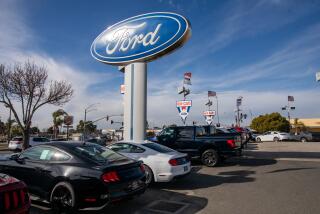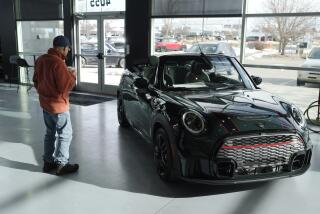THE Goods : Hot Wheels : Affordability. Style. Low cost. What more could children--and their parents--ask for in a first car?
Teen-agers bent on terrorizing their parents need only request advice--for a friend, you understand--on collagen injections, eloping with first cousins, body piercing, gender confusion and tuition fees for Oxford.
Or they can pop the reeeeally petrifying question: When can I have a car of my own? What typically follows is the worldâs oldest argument, raging since Julia Caesar begged Dad for the keys to the chariot. The young and the relentless talk Ferrari. Mom and Dad counter with something sedate and used from GM.
To assist future harmony in the home--and as clear proof that parents can prevail, and sometimes by enormous margins--it is worth noting that Ferrari sold only 550 cars in the United States last year.
Chevrolet, on the other hand, sold 273,617 Cavalier coupes, sedans and convertibles, and more than 22% were bought by first-time buyers under 25.
Whether financed by parents or the proceeds of a studentâs Subway summer, the spirited, economical, subcompact, gallant Cavalier is the nationâs best-selling automotive primer.
The second-most popular new car is the Nissan Sentra--with 20% of all sales to first-time buyers. In third and fourth places are the Honda Civic (17%) and the Ford Escort (11%).
âThey are exactly what youngsters want and parents can afford . . . low cost, economical, practical cars with some sort of style,â says John Rettie of J.D. Power and Associates, the analytical judge, jury and executioner of automotive brands and trends. âAll are safe cars with air bags--or moving in that direction--with strong wheels, good brakes and federally regulated side-impact protection.â
Geo Storms also ride high among young fancies. So do Honda Accords, Hyundai Scoupes, Toyota Paseos and other compacts for which monthly insurance payments--unlike those for Porsches and Corvettes--do not exceed purchase payments.
Yet Cavaliers and Civics are small, basically equipped, lightly powered cars that wouldnât seem to fit the driving fantasies of youth. They also are sold by the tens of thousands with body color the only distinction in a high school parking lot.
Fortunately, says KTLA-TV Car Dude Steve Parker, the era of ugly, square, rattling econoboxes is dead. Only masochists mourn the Ford Pinto. Buying cheap and nasty is no longer the buyer punishment for not being able to afford anything better.
Parker sees todayâs cars as little sophisticates. Like other experts, he believes lightness and agility translate to safety because they give a car a talent for getting out of harmâs way. Heâs impressed by cars that once needed engine replacements at 27,000 miles now traveling 100,000 miles between tuneups.
And once first-year sales numbers are in, he believes, Chryslerâs newborn Neon--a subcompact sold by Dodge and Plymouth dealers--will be bigger than Chevyâs Cavalier or even Boyz II Men among American youngsters.
âThe most car for the money is of course the age-old argument,â Parker explains. âNeon is that, but also a fashion statement, a stylish, high-performing, safe, dependable car . . . maybe the first American compact to make money since Ralph Nader killed the Corvair.
âNow we have the perfect compromise car, and thatâs why itâs selling like crazy.â
*
Nobody keeps numbers on secondhand sales. But industry sources agree that most first-time buyers prefer used cars. And that improvements in car building have taken much of the automotive roulette out of buying pre-owned.
âWith todayâs cars, you can often look at the mileage and see how much life is left,â says syndicated automotive columnist Tom Keane. âIf a used car has 50,000 miles, you really donât have to worry until the speedometer rolls over.
âSo a 1-, 2- or even 3-year-old car should see a high-school senior through college.â
Keane also recommends shopping for used cars at established new-car dealerships whose trade-in lots usually are crammed with cream puffs taken in exchange or purchased at auction.
âWith a reputation to uphold, they arenât interested in selling you a beater,â he adds. âTheyâll wholesale that to Big Jimâs Used Cars because Big Jim doesnât have anything to lose.â
Other car tips from the experts:
* The popularity of Honda, Nissan, Toyota and other new compacts rests with reliability. The used models generally retain that dependability.
* Donât overlook used mini-trucks for college-age drivers. They are tough, inexpensive and very cool.
* A prime time for lot shopping is late summer, when salespeople turn in their demonstrators for next yearâs models. And keep an eye open for low mileage, repossessed cars.
* Study Consumer Guideâs âAutomobile Book,â which gives impartial reviews of all new cars. More important, it lists dealer invoice, retail and fair prices. Call (708) 676-3470 for local outlets that carry the guide.
At the risk of being attacked as sexist by her own sex, Jill Amadio, car columnist for Entrepreneur, believes young women buy their first cars for all the wrong reasons. They also are hung up on horsepower when âyoung women, as a group, are the most dangerous drivers on the road.â
Female first-timers typically âlook for pretty things . . . whatâs hip, whatâs the jazzy color, like the (Toyota) Supra with a bright red dash,â Amadio says.
âThey donât want to be feminine feminine, like the (Infiniti) J30 . . . but they do like the (Honda) Del Sol, (Volkswagen) GTI and Geo Metro convertible.â
*
So what are parents to do? Homework, Amadio recommends. And without their darling daughters knowing.
âMom and Dad should visit the dealerships, read the magazines and consumer reviews, find out what is safe and cute,â she explains. âThen you can give the youngsters options. Remember, parents do have control, so exercise it.â
As a psychologist, Linda Bailey-Martiniere recognizes all traps facing car-buying parents. They donât want their children driving Yugos and being ostracized by peers as major geeks. Nor must parents buy into second-mortgaging the house so junior can be indulged with a designer label, such as a BMW.
âYou are not going to communicate anything to kids by giving them keys to a BMW,â Bailey-Martiniere says. âExcept to communicate that this is a gift.â
Among the rules of her road to first-car ownership:
* Although a car is a young personâs rite of passage, it remains a parentâs right not to give the child a car.
* The sticker price includes being a responsible citizen because that creates responsible drivers.
* No matter the parental investment, the car should be a youngsterâs financial responsibility at least in part.
Then, Bailey-Martiniere suggests, close for the kill.
âTell them: âYou want the BMW? Youâll have to work X number of hours a week at maybe two jobs. There will be no time for football and no time for friends.â
âThen suggest a Ford Escort that will allow them football and friends. Work down to it. And always give them choices.â
No psyching was necessary when Ann Clinard, 16, of Irvine, a student at University High School, recently chose her first car. Among the ecumenical suggestions made by her father, Ford employee John Clinard, were a used Alfa-Romeo and a new Mustang convertible.
Ann picked a Ford Escort because she isnât hooked on status and high visibility.
âI just wanted a nice-looking car that wouldnât draw attention to me,â she says, âsomething with four doors, a good radio, a roomy car because Iâd have a lot of people to drive around.
âAnd with an Escort, I can spend only $10 a week on gas and go anywhere.â






